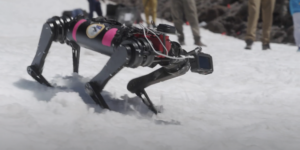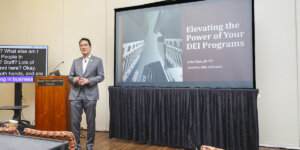Time to level up at USC’s Information Sciences Institute (ISI). The world leader in computer science research has launched a new career path for its research engineers, effective March 1st, 2022. ISI has decided to let go of the only two positions available to them prior to this work, and to create six research engineer levels instead based on skills, education, performance, and experience. A change with several objectives in mind. Some practical, some more philosophical.
This work takes its roots in a movement initiated in England about 5 years ago regarding the uniqueness of being a software engineer in a research team. University and research bodies agreed that programmers who worked in research should get a research position as well. “We wanted to recognize that building software in a research environment is very different from building software in a corporate environment,” explained Dr. Terry Benzel, director of the Networking and Cybersecurity division at ISI. “If you work for the industry, you have a very defined end product. You know exactly what you are building, and you write your code according to the specifications you are given. In a research environment you are part of a research team. We are all exploring what we want to build, how it’s going to work and what it is going to do. Those job positions are a recognition of our engineers’ level of contribution to research projects.” Benzel is hopeful that this new system will help attract talents as well: “ People should come work at ISI because they can be a research engineer, not just a programmer. They get to contribute to the research and are a vital part of it, they can have their name on the research, present to the sponsors, help write proposals.” She would also love to see them involved in professional societies like The United States Research Software Engineer Association to contribute to the discussion on the research engineer field. “ISI pays for your fees if you join a professional society,” reminded Benzel.
Pressing HR needs
Internally, this transition comes at a time where ISI needed to broaden its offer to engineers, and become a place that promotes growth over the years. “The immediate need was that there was nowhere to go. If you were hired at anything other than Research Engineer 1, you were in a final position and we could not offer you career growth. This was not a way to value people in this track,” explained Liz Boschee, research team leader and associate director of the artificial intelligence division at ISI. She served as a member of the committee who worked on this project. Karan Vahi, senior computer scientist at ISI, concurred: “For a programmer the career path was ad hoc and ill defined. A lot of MS students at USC would get hired as RP1, so after their first promotion they were at the end of their career track.” They now have the options of Research Engineer I, Research Engineer II, Sr. Research Engineer I, Sr. Research Engineer II, Lead Research Engineer, Principal Research Engineer. “Programmer” and “Software” titles were dropped so those new positions would apply to all types of engineers working at ISI. All levels have criteria of achievements and responsibilities, but managing is never mandatory. “We did not want to lock people in, so they could succeed in different ways and have the potential for full growth in the company,” added Boschee.
Another flaw the committee wanted to resolve was the lack of consistency in positions at ISI. “There were random titles floating around, based on arbitrary decisions. You don’t want Bob and Sheila doing the same job with different denominations. It also made it harder to achieve salary parity”, said Boschee. With better defined positions, ISI wants to “offer transparency when it comes to the expectations for each role, as well as guidelines to evaluate each person’s work fairly,” explained Marjorie Freedman, research team leader and chair of the committee. Derek Mikuriya, director of human resources at ISI, points out that those specifications will also be very helpful during performance reviews and to grant promotions.
While Boschee expects an impact on retention as well, she is also thoughtful of ISI’s engineers career path as a whole: “We never want to see people leave ISI but if they do we want them to have a strong resume to go wherever they want to go. What is important is showing progression, that you were promoted through those different levels of responsibilities because you were valued by your company. That is something they will be able to show, should they choose one day to leave ISI. We want people to be set up for success here, but also in their career in general whether that’s here or somewhere else.”
Published on April 15th, 2022
Last updated on May 16th, 2024












